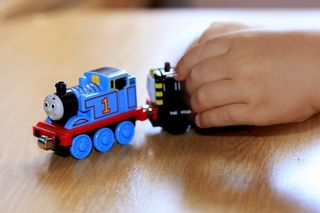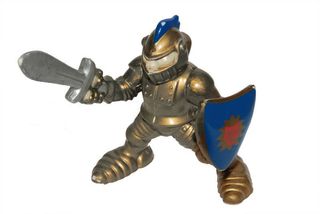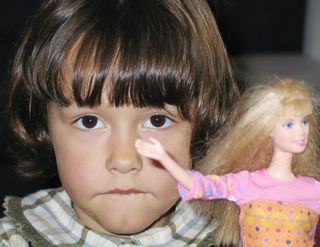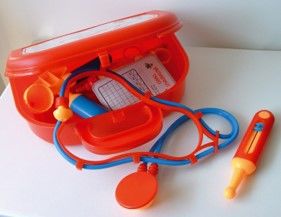Play
How Children’s Toys and Play Affect Adulthood
Children’s play has a strong influence in shaping their future adult identities.
Posted May 10, 2020 Reviewed by Kaja Perina

If you can recall, what types of play did you engage in when you were a child? Were they typical “boy” or “girl” styles of play, or non-gender-conforming? If you’re currently the parent of a young child or children, are their toys and style play gender-specific, gender-neutral, or both? How can childhood play experiences affect adulthood?
According to psychologist Jean Piaget’s cognitive development theory, children learn by interacting with their environment, from which they acquire maturation and skills (and sometimes deficient maturation and/or skills) toward adulthood. The ways children play (i.e., dress-up, superhero, super-heroine, princess, scientist, magician, artist, athlete), how they play (i.e., competitive or cooperative), and whom they play with (i.e., alone, with children of the same sex, with children of both sexes) have a strong influence in shaping and developing their future adult identities. In particular, toys and play affect children’s interest in future careers, whether they become well-rounded individuals, and how healthy and mature they relate to members of the same and opposite sex.
Boys’ Toys and Playstyles

Many toys and games designed for boys, marketed to boys, and played mostly by boys (i.e., football and baseball, combat video games, Dungeons and Dragons, action figures, etc.) have the common themes of goal setting and conquest, overcoming multiple challenges and “dangers,” tests of strength and skill, competition with other human players or game characters for control, and “success” at the end of game measured by tangible rewards (i.e., points, accomplishments, “kills,” levels of power and mastery, etc.).
Girls’ Toys and Playstyles

Many toys and games designed for girls, marketed to girls, and played mostly by girls (i.e., house, dolls, tea party, fashion show, computer real-life simulation, etc.) have the common themes of cultivating relationships, with flexible roles (i.e., taking turns being host and guest), and communication utilized as a primary vehicle for social cooperation. Many traditional girls’ games do not necessarily have a formal “end”—the purpose of the game is the process of interacting, communicating, and collaborative problem-solving. That said, some girls’ games, particularly certain types of sports, engage in competition as well.
In many ways, children’s play is like conscious or unconscious “rehearsals” of preparing for adulthood. In this regard, the diversity of playing methods (as opposed to gender stereotype conformance) can have a significant impact on the overall well-roundedness of children’s identities going forward.
“The stereotypes we see in toy marketing connect with the inequalities we see in adult life. By late primary age, research … shows that children already have very clear ideas about the jobs that are suitable for boys and girls; ideas that are very hard to shake later on.”
—Let Toys Be Toys campaign
Benefits of Gender-Neutral/Gender-Inclusive Games and Toys

There are multiple developmental and maturation advantages to providing children with gender-neutral/gender-inclusive play and games such as puzzles, board games, building blocks, chess, and checkers, wheeled toys or equipment (i.e., bicycle, Radio Flyer), puppets, musical instruments, art kits, magic kits, science kits, medical kits, robotics kits, gender-inclusive ball games, water activities and water sports, activities involving exercising or dancing, activities involving nature, activities involving learning about animals, creative imaginary play, and even Pokémon.
Benefits of gender-neutral/gender-inclusive games and toys include:
- They do not confine and limit girls and boys to gender stereotypes.
- They introduce children to a broader range of developmental learning, resulting in potentially better performance in school.
- They expose children to a wider spectrum of cognitive subjects and environments, leading to the potential of greater future career interests, options, and pursuits.
- They may facilitate greater left brain and right brain development.
- They encourage healthy, collaborative socialization with peers of the same sex as well as the opposite sex, with an influence on future adult relationships.
“I never had a desire for anything girl related as a kid because the commercials/ads made it clear what toys were for boys and which toys were for girls. Until one day kids were introduced to something that I believe changed the way our generation grew up. Pokémon. A complete counter to all gender stereotypes! Some Pokémon didn’t even have a gender. I truly believe Pokémon played a major part in creating an environment where boys and girls can play together without any judgement…a gender-neutral game that both boys and girls could enjoy.”
—Marcus Coleman, student
What is your experience of children’s games and toys (either from childhood or as a parent)? Feel free to share in the comments.
For tips on how to communicate effectively with children and teenagers, see references below.
© 2020 by Preston C. Ni. All rights reserved worldwide. Copyright violation may subject the violator to legal prosecution.
References
Ni, Preston. How to Communicate with Highly Sensitive People. PNCC. (2017)
Ni, Preston. How to Communicate Effectively and Handle Difficult Teenagers. PNCC. (2015)
Ni, Preston. How to Let Go of Negative Thoughts and Emotions. PNCC. (2014)
Ni, Preston. Are You Highly Sensitive? How to Gain Immunity, Peace, and Self-Mastery!. PNCC. (2017)
Amen, Daniel. Change Your Brain, Change Your Life. Three River Press. (1999)
McLeod, S. A. Jean Piaget's Theory of Cognitive Development. Simply Psychology. (2018)
Piaget, J. Origins of Intelligence in the Child. London: Routledge & Kegan Paul. (1936)
Siegler, R. S., DeLoache, J. S., & Eisenberg, N. How Children Develop. New York: Worth. (2003)
Spinner, L., Cameron, L. & Calogero, R. Peer Toy Play as a Gateway to Children’s Gender Flexibility: The Effect of (Counter) Stereotypic Portrayals of Peers in Children’s Magazines. Sex Roles. (2018)


